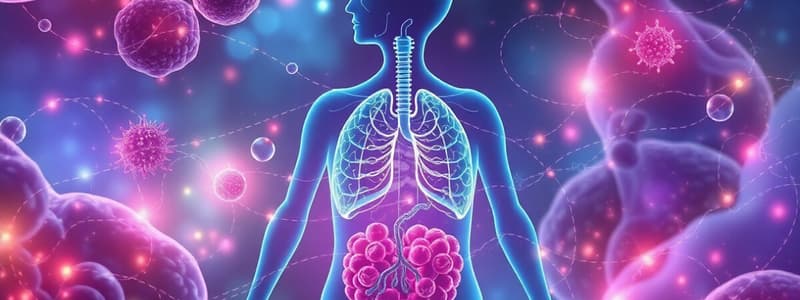Podcast
Questions and Answers
What is the primary function of cellular respiration?
What is the primary function of cellular respiration?
- To break down organic molecules for ATP production (correct)
- To synthesize glucose from carbon dioxide
- To transport oxygen throughout the body
- To convert light energy into chemical energy
Which of the following statements best describes anaerobic respiration?
Which of the following statements best describes anaerobic respiration?
- It is more efficient than aerobic respiration
- It exclusively occurs in human cells
- It occurs only in the presence of oxygen
- It produces significantly less ATP than aerobic respiration (correct)
Which of the following processes occurs during aerobic respiration?
Which of the following processes occurs during aerobic respiration?
- Glycolysis (correct)
- Lactic acid conversion
- Fermentation
- Calvin cycle
What are the end products of alcohol fermentation?
What are the end products of alcohol fermentation?
During which stage of cellular respiration is carbon dioxide produced?
During which stage of cellular respiration is carbon dioxide produced?
What is the purpose of the electron transport chain?
What is the purpose of the electron transport chain?
What occurs during glycolysis?
What occurs during glycolysis?
What is a characteristic of aerobic respiration?
What is a characteristic of aerobic respiration?
Which statement accurately differentiates between lactic acid and alcohol fermentation?
Which statement accurately differentiates between lactic acid and alcohol fermentation?
Where does the Krebs cycle take place?
Where does the Krebs cycle take place?
Flashcards
What is cellular respiration?
What is cellular respiration?
A metabolic process that breaks down organic molecules to release energy in the form of ATP (adenosine triphosphate). This energy is used for essential cellular activities.
What is anaerobic respiration?
What is anaerobic respiration?
A type of respiration that occurs in the absence of oxygen, producing less ATP than aerobic respiration.
What is aerobic respiration?
What is aerobic respiration?
A type of respiration that requires oxygen, producing a much greater amount of ATP than anaerobic respiration.
What is alcohol fermentation?
What is alcohol fermentation?
Signup and view all the flashcards
What is lactic acid fermentation?
What is lactic acid fermentation?
Signup and view all the flashcards
What is glycolysis?
What is glycolysis?
Signup and view all the flashcards
What is the Krebs cycle?
What is the Krebs cycle?
Signup and view all the flashcards
What is the electron transport chain?
What is the electron transport chain?
Signup and view all the flashcards
What is the role of oxygen in aerobic respiration?
What is the role of oxygen in aerobic respiration?
Signup and view all the flashcards
What is ATP?
What is ATP?
Signup and view all the flashcards
Study Notes
Cellular Respiration Overview
- Cellular respiration is a metabolic process that breaks down organic molecules to release energy in the form of ATP (adenosine triphosphate). This energy is used for cellular activities.
- It's a central process for all living organisms.
- Two main types exist: anaerobic (without oxygen) and aerobic (with oxygen).
Anaerobic Respiration
- This type of respiration occurs in the absence of oxygen.
- It's less efficient than aerobic respiration, producing much less ATP.
- It involves a substrate being broken down by enzymes to produce energy in the form of ATP and reduced products.
Aerobic Respiration
- This type of respiration requires oxygen.
- It's highly efficient, producing a large amount of ATP.
- It involves a series of reactions, including glycolysis, the Krebs cycle, and the electron transport chain.
Two Types of Fermentation
- Fermentation is an anaerobic process that follows glycolysis.
- Alcohol fermentation: This involves the conversion of pyruvate to ethanol and carbon dioxide. Common in yeast and some bacteria.
- Lactic acid fermentation: Involves the conversion of pyruvate to lactic acid. Found in animal muscle cells during strenuous exercise when oxygen supply is limited.
Glycolysis
- Glycolysis is the first stage of both aerobic and anaerobic respiration.
- It occurs in the cytoplasm of the cell.
- It involves breaking down glucose (a 6-carbon molecule) into two molecules of pyruvate (a 3-carbon molecule).
- This process yields a small amount of ATP and NADH (electron carriers).
Krebs Cycle (Citric Acid Cycle)
- Occurs in the mitochondrial matrix (in eukaryotes).
- Pyruvate from glycolysis is further oxidized to release carbon dioxide.
- It produces ATP, NADH, FADH2 (electron carriers), and some byproducts.
- The cycle repeats for each original glucose molecule.
Electron Transport Chain (ETC)
- Takes place in the inner mitochondrial membrane (in eukaryotes).
- NADH and FADH2 from glycolysis and the Krebs cycle donate electrons to a series of protein complexes.
- The electron transfer releases energy, which is used to pump hydrogen ions (protons) across the membrane creating a gradient.
- The movement of hydrogen ions back across the membrane through ATP synthase generates ATP.
- Oxygen acts as the final electron acceptor, combining with hydrogen ions to form water.
Photosynthesis
- Photosynthesis is the process by which plants and some other organisms convert light energy into chemical energy in the form of glucose.
- Two main types of reactions: Light-dependent and light-independent (Calvin cycle).
- Light-dependent reactions capture light energy and convert it into chemical energy stored in ATP and NADPH.
- Light-independent (Calvin cycle) reactions use ATP and NADPH to convert carbon dioxide into glucose.
- It occurs in chloroplasts.
Studying That Suits You
Use AI to generate personalized quizzes and flashcards to suit your learning preferences.




